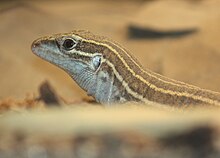Agamogenesis
Agamogenesis is any form of reproduction that does not involve a male gamete. Examples are parthenogenesis and apomixis.
Parthenogenesis
Parthenogenesis is a form of agamogenesis in which an unfertilized egg develops into a new individual. It has been documented in over 2,000 species.[21] Parthenogenesis occurs in the wild in many invertebrates (e.g. water fleas, rotifers, aphids, stick insects, some ants, bees and parasitic wasps) and vertebrates (mostly reptiles, amphibians, and fish). It has also been documented in domestic birds and in genetically altered lab mice.[22][23] Plants can engage in parthenogenesis as well through a process called apomixis. However this process is considered by many to not be an independent reproduction method, but instead a breakdown of the mechanisms behind sexual reproduction.[24] Parthenogenetic organisms can be split into two main categories: facultative and obligate.
Facultative parthenogenesis
In facultative parthenogenesis, females can reproduce both sexually and asexually.[21] Because of the many advantages of sexual reproduction, most facultative parthenotes only reproduce asexually when forced to. This typically occurs in instances when finding a mate becomes difficult. For example, female zebra sharks will reproduce asexually if they are unable to find a mate in their ocean habitats.[2]
Parthenogenesis was previously believed to rarely occur in vertebrates, and only be possible in very small animals. However, it has been discovered in many more species in recent years. Today, the largest species that has been documented reproducing parthenogenically is the Komodo dragon at 10 feet long and over 300 pounds.[25][26]
Heterogony is a form of facultative parthenogenesis where females alternate between sexual and asexual reproduction at regular intervals (see Alternation between sexual and asexual reproduction). Aphids are one group of organism that engages in this type of reproduction. They use asexual reproduction to reproduce quickly and create winged offspring that can colonize new plants and reproduce sexually in the fall to lay eggs for the next season.[27] However, some aphid species are obligate parthenotes.[28]
Obligate parthenogenesis
In obligate parthenogenesis, females only reproduce asexually.[21] One example of this is the desert grassland whiptail lizard, a hybrid of two other species. Typically hybrids are infertile but through parthenogenesis this species has been able to develop stable populations.[29]
Gynogenesis is a form of obligate parthenogenesis where a sperm cell is used to initiate reproduction. However, the sperm's genes never get incorporated into the egg cell. The best known example of this is the Amazon molly. Because they are obligate parthenotes, there are no males in their species so they depend on males from a closely related species (the Sailfin molly) for sperm.[30]
Apomixis and nucellar embryony
Apomixis in plants is the formation of a new sporophyte without fertilization. It is important in ferns and in flowering plants, but is very rare in other seed plants. In flowering plants, the term "apomixis" is now most often used for agamospermy, the formation of seeds without fertilization, but was once used to include vegetative reproduction. An example of an apomictic plant would be the triploid European dandelion. Apomixis mainly occurs in two forms: In gametophytic apomixis, the embryo arises from an unfertilized egg within a diploid embryo sac that was formed without completing meiosis. In nucellar embryony, the embryo is formed from the diploid nucellus tissue surrounding the embryo sac. Nucellar embryony occurs in some citrus seeds. Male apomixis can occur in rare cases, such as the Saharan Cypress Cupressus dupreziana, where the genetic material of the embryo are derived entirely from pollen.
https://en.wikipedia.org/wiki/Asexual_reproduction#Agamogenesis
Parthenogenesis (/ˌpɑːrθɪnoʊˈdʒɛnɪsɪs, -θɪnə-/;[1][2] from the Greek παρθένος, parthénos, 'virgin' + γένεσις, génesis, 'creation'[3]) is a natural form of asexual reproduction in which growth and development of embryos occur in a gamete (egg or sperm) without combining with another gamete (e.g., egg and sperm fusing).[4] In animals, parthenogenesis means development of an embryo from an unfertilized egg cell. In plants, parthenogenesis is a component process of apomixis. In algae, parthenogenesis can mean the development of an embryo from either an individual sperm or an individual egg.[4]
https://en.wikipedia.org/wiki/Parthenogenesis
In botany, apomixis is asexual reproduction without fertilization.[1] Its etymology is Greek for "away from" + "mixing". This definition notably does not mention meiosis. Thus "normal asexual reproduction" of plants, such as propagation from cuttings or leaves, has never been considered to be apomixis, but replacement of the seed by a plantlet or replacement of the flower by bulbils were categorized as types of apomixis. Apomictically produced offspring are genetically identical to the parent plant.
Some authors included all forms of asexual reproduction within apomixis, but that generalization of the term has since died out.[2]
In flowering plants, the term "apomixis" is commonly used in a restricted sense to mean agamospermy, i.e., clonal reproduction through seeds. Although agamospermy could theoretically occur in gymnosperms, it appears to be absent in that group.[2]
https://en.wikipedia.org/wiki/Apomixis




No comments:
Post a Comment